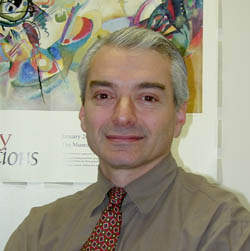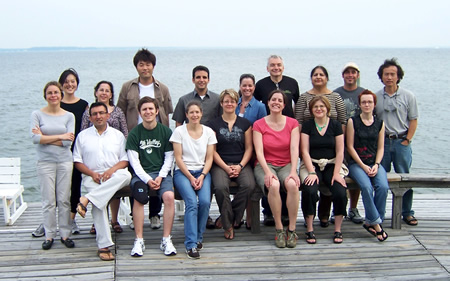|
|
 |
Back to Previous Page Previous Page
Human Cortical Physiology and Stroke Neurorehabilitation Section

Leonardo G. Cohen, M.D., Senior Investigator
Dr. Cohen received his MD from the University of Buenos Aires. He did his neurology residency at Georgetown University and received postdoctoral training in clinical neurophysiology at the Department of Neurology, University of California (Irvine) and in motor control and movement disorders at the Human Motor Control Section, NINDS. In 1998 he became chief of the Human Cortical Physiology Section, NINDS. He received the prestigious Humboldt award (1999) from the Republic of Germany and is an elected member of the American Neurological Association. Dr. Cohen's lab is interested in the mechanisms underlying plastic changes in the human central nervous system and in the development of novel therapeutic approaches for recovery of function based on the understanding of these mechanisms.
Staff:

- Mitsunari Abe, Ph.D., Postdoctoral Fellow abem@ninds.nih.gov
- Ethan Buch, Predoctoral Fellow buchet@mail.nih.gov
- Katherine Deutsch, Ph.D., Postdoctoral Fellow deutschk@ninds.nih.gov
- Michael Dimyan, M.D., Clinical Fellow dimyanm@ninds.nih.gov
- Alissa Fourkas, Ph.D., Postdoctoral Fellow fourkasa@ninds.nih.gov
- Michelle Harris-Love, Ph.D., Research Fellow harrislmi@mail.nih.gov
- Timea Hodics, M.D., Senior Research Fellow hodicst@ninds.nih.gov
- Miss. Stephanie Maxwell, B.A., Doctoral Student maxwells@ninds.nih.gov
- Susanne Morton, Ph.D., Postdoctoral Fellow mortonsu@mail.nih.gov
- Monica Perez, Ph.D., Research Fellow perezmo@ninds.nih.gov
- Mrs. Shashi Ravindran, M.P.H., Senior Research Assistant, 301-402-1916 ravindrs@ninds.nih.gov
- Heidi Schambra, M.D., Clinical Postdoctoral Fellow schambrah@mail.nih.gov
- Nick Sharma, M.D., Clinical Postdoctoral Fellow sharman@ninds.nih.gov
- Sylvie Song, Ph.D., Predoctoral Fellow songs@ninds.nih.gov
- Benjamin Xu, Ph.D., Staff Scientist benxu1@mail.nih.gov
 |  |
Research Interests:
The goal of our activity is to understand the mechanisms underlying plastic changes in the human central nervous system (CNS) and to develop novel therapeutic approaches for recovery of function based on these advances. Our work has focused on the human motor system and on plastic changes taking place across sensory modalities for example in blind individuals (crossmodal plasticity). We have studied cortical reorganization in patients with CNS lesions in particular stroke and traumatic brain injury. In healthy volunteers, we studied cortical plasticity associated with deafferentation and motor skill learning.
We utilize different techniques in the context of well defined hypothesis-driven investigations including transcranial magnetic (TMS, video) and DC (tDCS) stimulation, fMRI, TMS in combination with fMRI, MR spectroscopy, diffusion tensor imaging (DTI), PET scanning and magnetoencephalography (MEG). We are interested in the development of these techniques to help us to understand mechanisms of human plasticity and to modulate human brain processes. Our research protocols in healthy volunteers are geared to identify mechanisms of human neuroplasticity and to develop interventional approaches to enhance them when they play a beneficial role and down-regulate them when they are maladaptive. Advances in this understanding in healthy volunteers are subsequently applied to patients with neurological conditions like stroke in attempts to enhance neurorehabilitative processes. In blind individuals, we seek to understand the mechanisms underlying the remarkable compensatory processes involved in crossmodal plasticity, and to facilitate them using noninvasive techniques.
Our future goals are to improve our understanding of mechanisms underlying plasticity of function in humans. On the basis of these insights, we are engaged in translational efforts to develop rational rehabilitative interventions to improve motor disability after stroke in particular using peripheral nerve stimulation, TMS and tDCS. In patients with severe hand paralysis, we use an MEG-based brain computer interface to control grasping motions of an orthosis attached to the paralyzed hand (video).
Clinical Protocols:
- Enhancement of rehabilitative treatment-dependent functional recovery after stroke by tDCS 04-N-0212
- Influence of lesion location on cortical reorganization after chronic stroke 07-N-0154
- Interhemispheric Interactions Associated with Performance of Voluntary Movements in Patients with Stroke Motor Disability 02-N-0104
- Effects of Unilateral and Bilateral Training on Motor Function in Chronic Stroke 05-N-0142
- LONG -TERM IMPROVEMENT IN TRAINING EFFECTS BY TRANSCRANIAL DC STIMULATION 06-N-0138
- Modulation of motor function by stimulation of the central and peripheral nervous system. 07-N-0122
Selected Publications:
- Birbaumer N, Ramos A, Murguialday AR and LG Cohen (InPress) Brain-computer interface in paralysis, Current Opinion in Neurology.
- Duque J, Mazzocchio R, Stefan K, Hummel F, Olivier F and LG Cohen. (2008) Memory formation in the motor cortex ipsilateral to a training hand, Cerebral Cortex 18, 1395-1406. Full Text/Abstract
- Perez M and LG Cohen (2008) Activity-dependent changes in motor cortical circuits ipsilateral to a moving hand, Journal of Neuroscience 28, 5631-40. Full Text/Abstract
- Perez M, Tanaka S, Wise S, Sadato N, Tanabe HC, Willingham DT and LG Cohen. (2007) Neural substrates underlying intermanual transfer of a newly acquired motor skill, Current Biology 17, 1896-1902. Full Text/Abstract
- Hummel F and LG Cohen (2006) Noninvasive brain stimulation. A novel strategy to enhance neurorehabilitation after stroke?, Lancet Neurology 5, 707-12. Full Text/Abstract
- Amedi A, Floel A, Knetch S, Zohary E and LG Cohen (2004) Transcranial magnetic stimulation of the occipital pole interferes with verbal processing in blind subjects, Nature Neuroscience 7, 1266-1270. Full Text/Abstract
- Werhahn KJ, Mortensen J, VanBoven RW, Zeuner KE and LG Cohen. (2002) Enhanced tactile spatial perception and cortical processing during acute hand deafferentation , Nature Neuroscience 5, 936-8. Full Text/Abstract
All Selected Publications
Contact Information:
Dr. Leonardo G. Cohen
Human Cortical Physiology and Stroke Neurorehabilitation Section
Medical Neurology Branch, NINDS
Building 10, Room 5N226
10 Center Drive MSC 1430
Bethesda, MD 20892-1430
Telephone: 301-496-9782 office,
301-402-1007 fax
Email: cohenl@ninds.nih.gov
|

